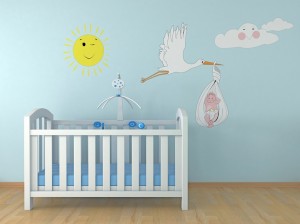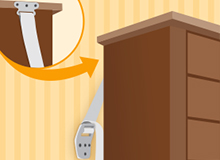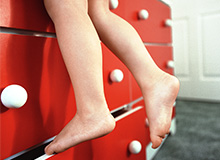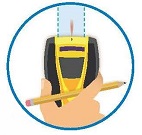Like what you are reading? Share it...
Checklist for Babyproofing Your Nursery

Use this checklist to babyproof your nursery and other rooms in your home. Children quickly can find trouble!
- Anchor furniture and televisions to prevent serious injuries from tip-overs. Even heavy pieces of furniture can become unstable if the doors or drawers are opened, pulled or climbed on. Anchoring or tethering devices must be designed to support the weight of the unit and must be securely fastened with screws into wall studs.
- Keep all furniture away from windows. This ensures that cribs are away from window coverings and helps prevent toddlers from climbing near windows.
- Cordless window treatments and blinds are best. Blinds with cords are a strangulation hazard. Go cordless!
- Install window guards or window stops on windows. A window stop prevents the window from opening more than a few inches (but has a release mechanism for emergency exit). Even if windows are above a child’s normal reach, a child might move a chair or toy in order to reach the window. Note: screens will not protect a child from falls and are meant to keep bugs outside.
- Use sliding outlet covers. Small removable outlet caps could be removed by toddlers and often are not replaced when the outlet is used. Some small caps are choking hazards.
- Ensure there are no electrical cords near the crib. This includes baby monitor electrical cords which are a strangulation risk. Please do not place any video monitors in the crib, on the crib, above the crib or near the crib (including wall-mounted models). Babies can reach through crib slats and pull cords into a crib. Install cords and monitors at least 3 feet away from the crib.
- Use “box covers” to hide plugs. If an electrical item is plugged in all the time, use a “box cover” type of outlet cover to hide the plug (small and large sizes are available).
- Extension cords should not be used in the nursery or throughout the house. Use surge protectors with a safety cover.
- Avoid free-standing lamps. Overhead lighting is best since table lamps or free-standing lamps can be pulled over by toddlers.
- Nightlights are best when placed out of the reach of your baby. Nightlights could be a hazard and some models allow easy access to the light bulb.
- Nothing in the crib is best (except your baby)! Because of the risk of suffocation, please do not use bumper pads, pillows, stuffed animals and blankets in a crib. Toys that are installed on the crib slats should be secured on the wall side (the manufacturer’s instructions should be checked). Avoid wall hangings above the crib.
- Use sleep sacks or sleepers instead of blankets in the crib. Hand-knitted blankets could unravel, exposing a long dangerous string. Other blankets are a suffocation risk.
- Check to make sure your crib has not been recalled. In recent years, numerous cribs have been recalled, mainly for hazards associated with the drop-side mechanisms. Crib standards have been improved so select cribs that meet current safety standards. New cribs will not have drop-side mechanisms. Visit www.cpsc.gov to check for recalls and crib safety information. Infants should sleep in cribs and not on adult beds or couches.
- Consider the use of finger pinch guards on doors to prevent serious injuries to fingers.
- Replace door stops with one piece safety door stops. The small rubber cap that is on many door stops is a choking hazard.
- Install carbon monoxide and smoke detectors. Follow the installation instructions provided by the manufacturer. The batteries must be changed regularly and detectors replaced at least every 10 years (check the manufacturer’s instructions because some may recommend replacement sooner, such as seven years for a CO detector).
- Furniture should not be placed close to a crib. An adjacent dresser could provide a foothold for climbing (if a dresser is directly against the crib) or it could cause entrapment if a child climbs out of the crib (the child could become entrapped between the crib and a dresser).
- Toy chests should have lid supports. This includes built-in chests. New toy chests may have lid supports. Old chests should not lock automatically (ensure the lid and the lock can be opened from the inside of the chest).
- Gliders could be a risk. A glider with exposed slats may give children access to moving parts and be a risk for finger injuries.
- Avoid step stools and little play chairs. Children often use them to gain access to items that are stored up high or windows. Some of them are not stable and designed for older children.
- Secure Changing Tables. Never leave a child unattended on a changing table (at any age). Ensure your baby can’t reach wall hangings, cords, diaper supplies or diaper ointments.
- Store medicines and poisons up high and in locked containers. Lock boxes are available for storing items. Button batteries are a serious hazard and can be found in household items such as bathroom scales and remotes.





